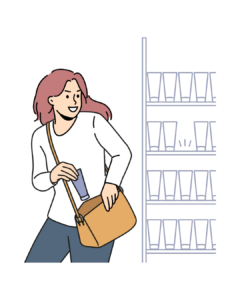Shrinkage
Inventory loss due to problems like staff theft, shoplifting, administrative errors, vendor fraud, damage, and cashier errors is referred to as inventory shrinkage. Shrinkage refers to the discrepancy between actual and recorded inventory on a company’s balance sheet. This concept presents a significant challenge for retailers, resulting in inventory and revenue losses.
The discrepancy between the physical inventory and the recorded inventor (book). The precise amount of stock a store should have is tracked using the dollar value in book inventory. The amount of inventory a merchant purchases to sell is listed as a current asset on the balance sheet.
Every retail business experiences shrinkage and some companies try to make up for it by raising the cost of currently available goods to cover inventory losses. However, the cost of theft and inefficiencies that could lead to product loss is passed along to the consumer due to these higher fees. In addition, shrinkage reduces a company’s customer base and forces customers to look for similar products elsewhere if they are price sensitive.
Retail Shrinkage

A business’s actions to lessen theft and fraud are referred to as retail shrinkage. Shrinkage is the term used to describe these avoidable losses, whether they result from human error or deliberate efforts.
Some businesses will increase client pricing to cover the cost of shrinking. They now have to deal with theft and incompetence. If your customers are price-sensitive, shrinkage can negatively impact sales and customer relationships.
Why is Calculating Shrinkage Important?
Loss is equated to shrinkage. The main problem is that shrinkage-related inventory losses prevent a store from recovering the cost of that inventory. Nothing is returned to the supplier; the retailer’s profit is subtracted. Retailers frequently choose between preventing future loss and making up for shrinkage.
Retailers should work to reduce shrinkage( and, if possible, get rid of it). However, it could be costly to accept shrinkage as a given and try to make up for the loss elsewhere.
To make up for lost revenue, costs( employee salaries, headcount, benefits, etc.) are typically increased or decreased.).
This might result in client loss and difficulties in retaining excellent personnel. Therefore, retailers should invest in loss prevention methods to avoid shrinkage rather than accepting it.
Average Shrinkage in Retail Industry
In retail, the typical shrink rate is 1.6% to 2% of sales. Although this may appear to be a small amount, it accounts for tens of billions of dollars in losses for merchants each year.
Calculating Shrinkage in Retail Business
The formula for calculating retail shrinkage is simple: take the ideal income you may generate from retail items and deduct the actual income received from that merchandise.
While retail shrinkage is sometimes evaluated in terms of total amounts lost, it is more accurately reported as a percentage of firm sales. To do so, divide your total losses by total sales to get your retail shrinkage percentage.
The Formula for Retail Shrinkage Percentage
(Value of Lost Stock/ Total Sales in the same period) * 100
Causes of Shrinkage in Retail
There are four leading causes of retail shrinkage; shoplifting, return fraud, administration errors, and employee theft.
– Shoplifting
Theft of goods from an open retail establishment is typically committed by leaving the store empty-handed while hiding a store item on one’s person in pockets, underwear, or bags. In addition, shoplifters may put on items from the store and then leave wearing them for clothing.
Shoplifters frequently serve as both lifters and distractors. The task of the distractor( s) is to divert salespeople by making time-consuming inquiries about things like where to find a specific item, whether they are stocking it, and other things. The actual thief is the lifter. While the distractor keeps sales staff engaged, the lifter snatches items.
Never undervalue the cunning of shoplifters, even though it’s crucial to be aware of the basics and watch out for them.
– Fraud
One of the most underutilized causes of retail loss is return fraud. Unfortunately, return fraud is ignored because it can be challenging to identify initially, with the repercussions only becoming apparent over time.
A person who purchases something from a physical store to return it immediately or uses duplicate receipts to get their money back is engaging in online fraud. Through the return process, a retail store is deceived. Fraudsters use a variety of tactics to commit this crime. For instance, a criminal may use someone else’s receipt to try to return an item they picked up off the store shelf, return stolen goods to obtain cash or take permits or receipt tape to allow for forged returns.
Theft or falsification of receipts to return goods for profit is known as receipt fraud. Another way to do this is to buy items from one store for a discount and then return them to another so that you can make money off of the difference.
When staff members assist you in returning stolen goods at the total cost, this is known as employee fraud. An example of insider fraud is this.
Price swapping is the practice of labeling products with higher prices so that shoplifters can resell them for more money than when they were first bought. This is comparable to profiting from receipt fraud’s price disparity.
Price arbitrage is buying identical-looking but different-priced items, returning the less expensive item as the more expensive one, and profiting from the difference.
– Administration Errors
Administrative mistakes, also called human errors, are accounting blunders that cause an accounting period’s expected and actual inventories to differ. For example, this kind of retail shrinkage can be caused by typos, mislabeled goods, and incorrect discounts. Even though these mistakes are unintentional, they can affect a business’s sales and profitability.
The overall success of your inventory depends on how your business handles damaged items. Sadly, several workers are unaware of how vital the damage process is. They occasionally dump the damaged item without going through the process of resolving the damages and taking it off inventory because they know management would throw it away. Failing to report damages can cause inventory loss even without theft.
– Employee Theft
Employee theft occurs when workers steal from or defraud a company. Retail shrinkage of this kind can also happen in a variety of ways. For example, employees may commit blatant theft by stealing items from a retail establishment. In addition, employee theft can occasionally manifest as fraud, such as overcharging a partner on purpose.
Because roughly half of the inventory shrinkage is caused by employees, take preventative measures. For example, security cameras and inventory controls, such as locking up essential products, deter potential thieves and make it easier to apprehend stealing employees.
Shrinkage Aftermath
There are several effects of shrinkage on a retail business. Such as:
Trust Issues Among Employees
Employee theft leads to shrinkage, affecting your business’s internal culture. Stores will implement bag and coat checks as employees enter and exit and monitor break rooms and other communal areas when things get terrible. This creates a significant barrier between managers and staff, especially those who don’t help. Morale suffers due to this sense of guilt from the association and the supervisors’ lack of trust.
Revenue Loss
Revenue loss is the effect of shrinking that is most obvious. The short and sweet of it is that your business will lose money if it shrinks. Shrinkage will happen if your inventory is stolen or destroyed or your tills consistently run low. Your bottom line is affected by each of these factors. Numerous challenges can lead to shrinkage, but the result is always a lower profit for the business.
Reduced Purchasing Power
Another effect of retail shrinkage on your organization is decreased purchasing power. You might be unable to pay your bills on time if your income declines. Your credit may be reduced or even canceled by your merchants. As a result, you might not be able to keep enough stock on hand for your business. Losing sales opportunities could further reduce your income.
Profitability Loss

In a market like retail, shrinkage could mean the difference between making money and going bankrupt. Long-term effects of shrinkage may affect your business’s profitability. Your business will likely be unprofitable for a long time. Other aspects of your business suffer as a result of this.
Lower Price
Have you got any investors? If so, you should think about how shrinking affects them. Over time, shrinkage reduces income and profitability, giving your shareholders lower returns. Additionally, it might lower the value of your stocks. First, examine large corporations’ financial statements. When there is good news, stock prices can rise, but share values decline when earnings are lower than anticipated.
Shrinkage may harm your company’s value if you plan to sell it. This is because you’ll receive a lower price when you put up the for-sale sign than you would otherwise.
How to Prevent Shrinkage?

High-quality customer service: Since customers are less likely to steal when they know that staff members are watching them, good client service practices like connecting with each individual in the business, checking in frequently, and staffing all shop areas will help reduce shoplifting shrink.
Designing retail facilities with clear lines of sight will help prevent shoplifting shrink. Employees should be able to see all areas at all times. As a result, potential shoplifters are less likely to steal unpaid-for goods when caught.
Background checks: By increasing the likelihood that new hires will be diligent and honest, screening your staff early can help prevent employee theft. Employee theft can occasionally become a habit, even though prior thefts do not guarantee they will steal from your company again.
Employee theft can be decreased by teaching staff about your expectations for essential cash management, customer service for friends and family, and employee discounts. In your training process, take into account explicit penalties for employee theft.
Ensure employees know all criminal schemes, such as customers returning goods without receipts or children interfering with salespeople’s theft. Can they deter thieves from committing crimes in any way? Yes! Additionally, your staff will be prepared to handle those situations if they arise with the proper training. Additionally, if your team believes something has been stolen, you must have procedures and strategies for them to follow.
A receipt must accompany returns because they typically show that the returned item was legitimately bought and wasn’t stolen. Therefore, to prevent return fraud, it is necessary to require a receipt with returns.
Employee Training

Training employees in effective fraud prevention techniques can be advantageous because employees are the ones who are most likely to come into contact with those trying to engage in return fraud. Therefore, your training materials should include knowledge of current fraudulent techniques and fraud prevention strategies.
Inventory monitoring and management: Technologies like point-of-sale (POS) software can assist you in identifying accounting issues as they arise or soon after, enabling you to use electronic tools or provide additional training to increase sales record accuracy
Conclusion
Any retail business, especially a small one, could suffer significantly from shrinkage. However, you can eventually run a more effective and productive interaction by taking proactive measures to eliminate it whenever possible.






